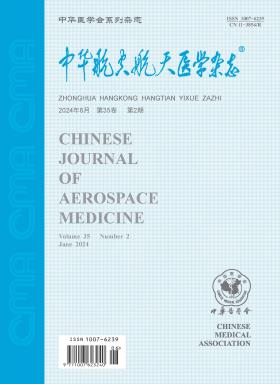Risk factors of asymptomatic colorectal polyps in flying personnel
引用次数: 0
Abstract
Objective To screen risk factors of asymptomatic colorectal polyps in flying personnel and to provide reference for diagnosing colorectal polyps. Methods A case-control study design was applied. One hundred and forty flying personnel who were had colonoscopy examination in our center from January 2014 to October 2018 were included. Cases with polyps were assigned as polyps group while others were assigned as control group. The clinic data of all cases were collected, such as age, height, weight, history of smoking, family history of malignant tumors of digestive tract in first-degree relatives, flying hours, cholesterol level, triglyceride level, blood glucose level, and the results of abdominal ultrasonography and colonoscopy examinations. The differences on indicators were compared between two groups by univariate analysis. The binary unconditional logistic regression models were used to analyze the risk factors of asymptomatic colorectal polyps in flying personnel. Results ①In 140 enrolled cases, 49 were assigned to polyps group and 91 to control group. The detection rate of polyps was 35.0%. ②Univariate analysis of data showed that two groups had statistical differences on age, body mass index, smoking history, family history of gastrointestinal cancer, flying hours, cholesterol levels, triglyceride levels, positive with fatty liver and positive with gallbladder changes (P<0.01 or 0.05). There was no significant difference in the fasting blood glucose between two groups. ③Logistic regression analysis showed that age and triglyceride level were the independent risk factors for colorectal polyps. The regression coefficient was 1.726 and 1.419, respectively. Conclusions Age and triglycerides level are independent risk factors for asymptomatic colorectal polyps in flying personnel. Increased body mass index, long-term smoking history, positive family history of gastrointestinal cancer, long flying hours, high cholesterol level, and positive with fatty liver or gallbladder disease may be the predictors of asymptomatic colorectal polyps in flying personnel. Key words: Colonic polyps; Risk factors; Hyperlipidemias; Flying personnel飞行人员无症状结直肠息肉危险因素分析
目的筛选飞行人员无症状结直肠息肉的危险因素,为结直肠息肉的诊断提供参考。方法采用病例-对照研究设计。纳入2014年1月至2018年10月在我中心行结肠镜检查的飞行人员140例。将有息肉者作为息肉组,其余为对照组。收集所有病例的临床资料,如年龄、身高、体重、吸烟史、一级亲属消化道恶性肿瘤家族史、飞行时间、胆固醇水平、甘油三酯水平、血糖水平、腹部超声及结肠镜检查结果等。采用单因素分析比较两组间各项指标的差异。采用二元无条件logistic回归模型对飞行人员无症状结肠息肉的危险因素进行分析。结果①140例入组患者中,息肉组49例,对照组91例。息肉检出率为35.0%。②单因素分析数据显示,两组患者年龄、体重指数、吸烟史、胃肠癌家族史、飞行时数、胆固醇水平、甘油三酯水平、脂肪肝阳性和胆囊改变阳性均有统计学差异(P<0.01或0.05)。两组空腹血糖无显著差异。③Logistic回归分析显示,年龄和甘油三酯水平是结直肠息肉的独立危险因素。回归系数分别为1.726和1.419。结论年龄和甘油三酯水平是飞行人员发生无症状结肠息肉的独立危险因素。体重指数增高、长期吸烟史、胃肠癌家族史阳性、飞行时间长、胆固醇水平高、脂肪肝或胆囊疾病阳性等可能是飞行人员发生无症状结直肠息肉的预测因素。关键词:结肠息肉;风险因素;高脂血症;飞行人员
本文章由计算机程序翻译,如有差异,请以英文原文为准。
求助全文
约1分钟内获得全文
求助全文
来源期刊

中华航空航天医学杂志
航空航天医学
自引率
0.00%
发文量
2962
期刊介绍:
The aim of Chinese Journal of Aerospace Medicine is to combine theory and practice, improve and popularize, actively advocate a hundred flowers bloom and a hundred schools of thought contend, advocate seeking truth from facts, promote the development of the related disciplines of aerospace medicine and human efficiency, and promote the exchange and penetration of aerospace medicine and human efficiency with other biomedical and engineering specialties.
Topics of interest for Chinese Journal of Aerospace Medicine include:
-The content of the journal belongs to the discipline of special medicine and military medicine, with the characteristics of multidisciplinary synthesis and cross-penetration, and mainly reflected in the aerospace industry, aerospace flight safety and efficiency, as well as the synthesis of special medicine, preventive medicine, environmental medicine, psychology, etc.
-Military aeromedicine (Air Force, Navy and Army aeromedicine) and civil aeromedicine, with a balance of aerospace medicine are the strengths of the journal.
-The change in aerospace medicine from a focus on promoting physiological compensatory adaptations to enhancing human performance under extreme environmental conditions is what the journal is helping to promote.
-The expansion of manuscripts in high altitude medicine is also a special emphasis of the journal.
 求助内容:
求助内容: 应助结果提醒方式:
应助结果提醒方式:


